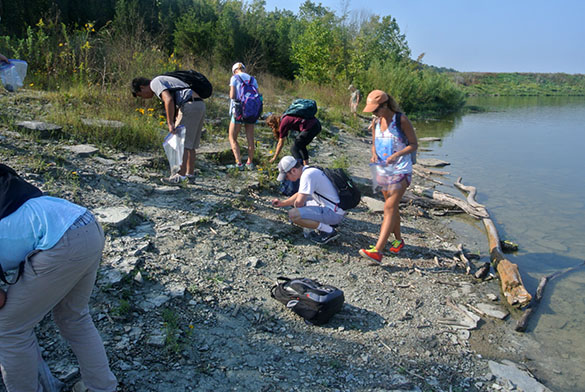 Ohio is a wonderful place for paleontologists. One of the reasons is the thick, productive set of Upper Ordovician rocks that are exposed in the southwest of the state in and around Cincinnati. It is an easy drive south from Wooster into some of the most fossiliferous sediments in the world. Today Wooster’s Invertebrate Paleontology class went to Caesar Creek Lake in Warren County with its shoreline and emergency spillway exposing richly productive limestones and shales of the Waynesville, Liberty and Whitewater Formations (all of which equal the Bull Fork Formation). I’ve been there many times with many classes. The weather today was hot and dry — a contrast with last year’s torrential rains and mud.
Ohio is a wonderful place for paleontologists. One of the reasons is the thick, productive set of Upper Ordovician rocks that are exposed in the southwest of the state in and around Cincinnati. It is an easy drive south from Wooster into some of the most fossiliferous sediments in the world. Today Wooster’s Invertebrate Paleontology class went to Caesar Creek Lake in Warren County with its shoreline and emergency spillway exposing richly productive limestones and shales of the Waynesville, Liberty and Whitewater Formations (all of which equal the Bull Fork Formation). I’ve been there many times with many classes. The weather today was hot and dry — a contrast with last year’s torrential rains and mud.
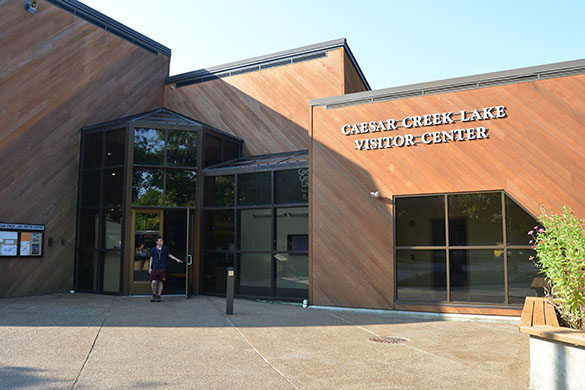 After a three-hour drive, we stopped first at the U.S. Army Corps of Engineers visitor center for Caesar Creek Lake. The Corps built the dam and spillway for the lake, and continues to maintain them both. This center has a set of museum displays and is where we obtain our fossil collecting permit. (This image was taken by Mara Sheban, a sophomore at The College of Wooster who will be contributing photographs to this blog and other geology projects.)
After a three-hour drive, we stopped first at the U.S. Army Corps of Engineers visitor center for Caesar Creek Lake. The Corps built the dam and spillway for the lake, and continues to maintain them both. This center has a set of museum displays and is where we obtain our fossil collecting permit. (This image was taken by Mara Sheban, a sophomore at The College of Wooster who will be contributing photographs to this blog and other geology projects.)
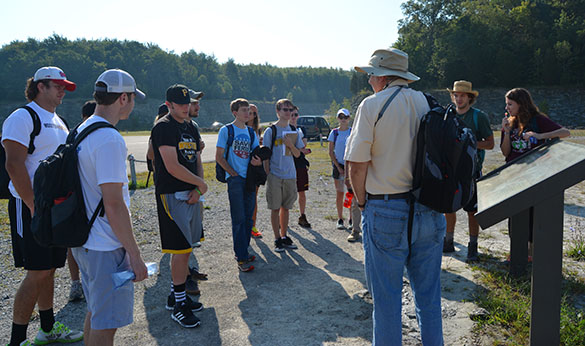 Our initial briefing, with a review of the local geology and most common fossils. Since this is the start of the Invertebrate Paleontology course, most students have only begun to explore the topic. The fossils they collect on this trip will be the basis of a semester-long project of systematics and paleoecological analysis. (Photo by Mara Sheban.)
Our initial briefing, with a review of the local geology and most common fossils. Since this is the start of the Invertebrate Paleontology course, most students have only begun to explore the topic. The fossils they collect on this trip will be the basis of a semester-long project of systematics and paleoecological analysis. (Photo by Mara Sheban.)
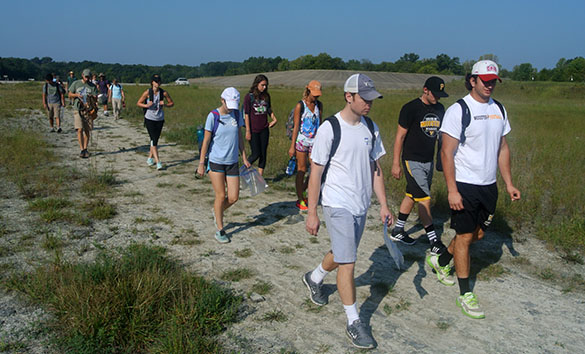 Our march to the far north of the exposures at the Caesar Creek Lake emergency spillway. We actually drop down from the spillway to the lake’s south shore. (See photo at the top of this post.) In the distant parking lot you can just make out a white pick-up truck in which the seasonal ranger is keeping an eye on us.
Our march to the far north of the exposures at the Caesar Creek Lake emergency spillway. We actually drop down from the spillway to the lake’s south shore. (See photo at the top of this post.) In the distant parking lot you can just make out a white pick-up truck in which the seasonal ranger is keeping an eye on us.
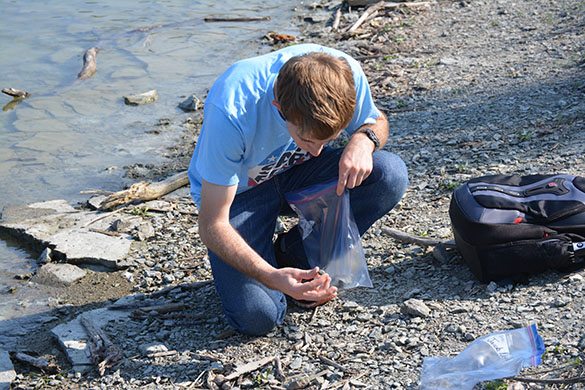 Jacob Nowell collecting small fossils washed from the shale along the lakeshore. (Photo by Mara Sheban.)
Jacob Nowell collecting small fossils washed from the shale along the lakeshore. (Photo by Mara Sheban.)
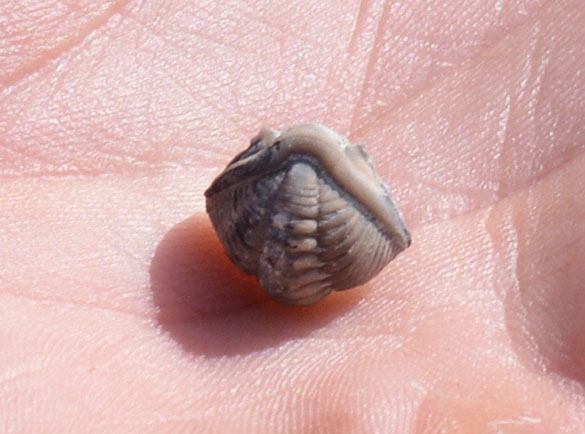 Jacob Pries found a nice enrolled Flexicalymene trilobite. Caesar Creek has a reputation as being a good place to find trilobites. We love them, but are also interested in the rest of the fossil fauna. (Mara Sheban image.)
Jacob Pries found a nice enrolled Flexicalymene trilobite. Caesar Creek has a reputation as being a good place to find trilobites. We love them, but are also interested in the rest of the fossil fauna. (Mara Sheban image.)
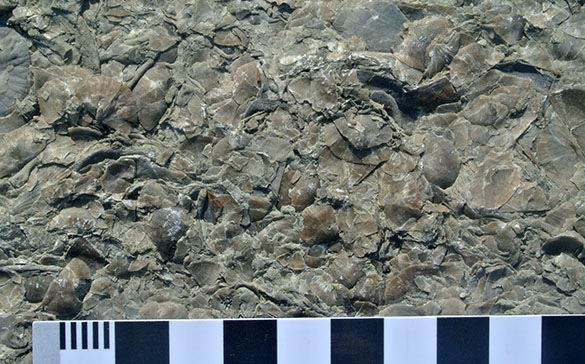 Some of the limestone units are a nearly solid hash of cemented brachiopod shells.
Some of the limestone units are a nearly solid hash of cemented brachiopod shells.
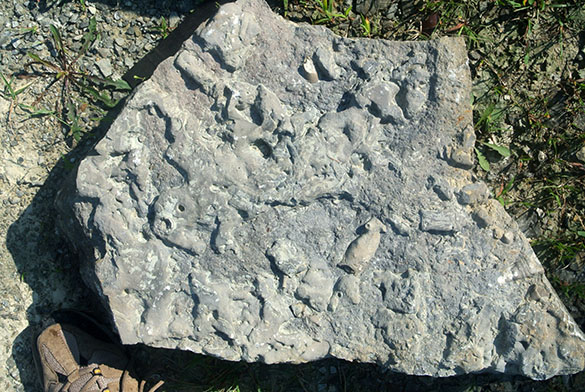 My favorite slabs at Caesar Creek Lake are the abundant carbonate hardgrounds like the above. A hardground is a cemented seafloor, usually with borings and encrusting organisms. This one began as a burrowed soft carbonate sediment. The burrows were filled with fine mud that cemented early on the seafloor. The surrounding softer matrix washed away, leaving a hardground with the burrows now in positive relief. Brachiopods and corals then lived in the nooks and crannies of this hard rock on the bottom of the sea.
My favorite slabs at Caesar Creek Lake are the abundant carbonate hardgrounds like the above. A hardground is a cemented seafloor, usually with borings and encrusting organisms. This one began as a burrowed soft carbonate sediment. The burrows were filled with fine mud that cemented early on the seafloor. The surrounding softer matrix washed away, leaving a hardground with the burrows now in positive relief. Brachiopods and corals then lived in the nooks and crannies of this hard rock on the bottom of the sea.
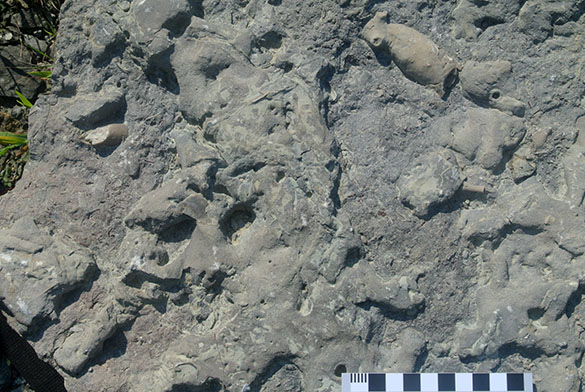 Here is the burrow system in a closer view. In the upper right is a beautiful encrusted rugose coral, shown in detail below.
Here is the burrow system in a closer view. In the upper right is a beautiful encrusted rugose coral, shown in detail below.
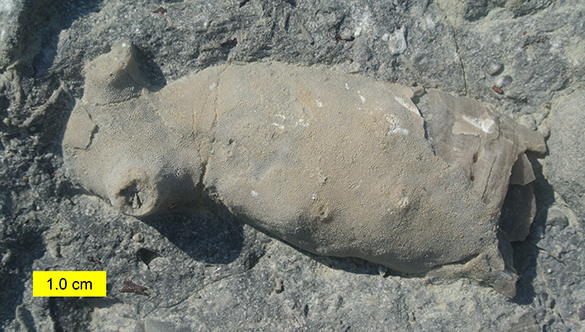 That coral is almost completely covered by a trepostome bryozoan. I would have loved to collect this specimen for further study, but the slab is too large and no tools are allowed on this outcrop.
That coral is almost completely covered by a trepostome bryozoan. I would have loved to collect this specimen for further study, but the slab is too large and no tools are allowed on this outcrop.
In the coming weeks we will identify the fossils we gathered, apply to them several paleontological techniques such as cleaning, cutting, polishing and photography, and then put together a grand paleoecological analysis. We will be greatly assisted by two fantastic websites, one by Alycia Stigall at Ohio University called The Digital Atlas of Ordovician Life, and the other by Steve Holland at the University of Georgia titled The Stratigraphy and Fossils of the Upper Ordovician near Cincinnati, Ohio.



Pingback: Phylum Brachiopoda: The Lamp Shells (September 22 & 24) | Invertebrate Paleontology at Wooster